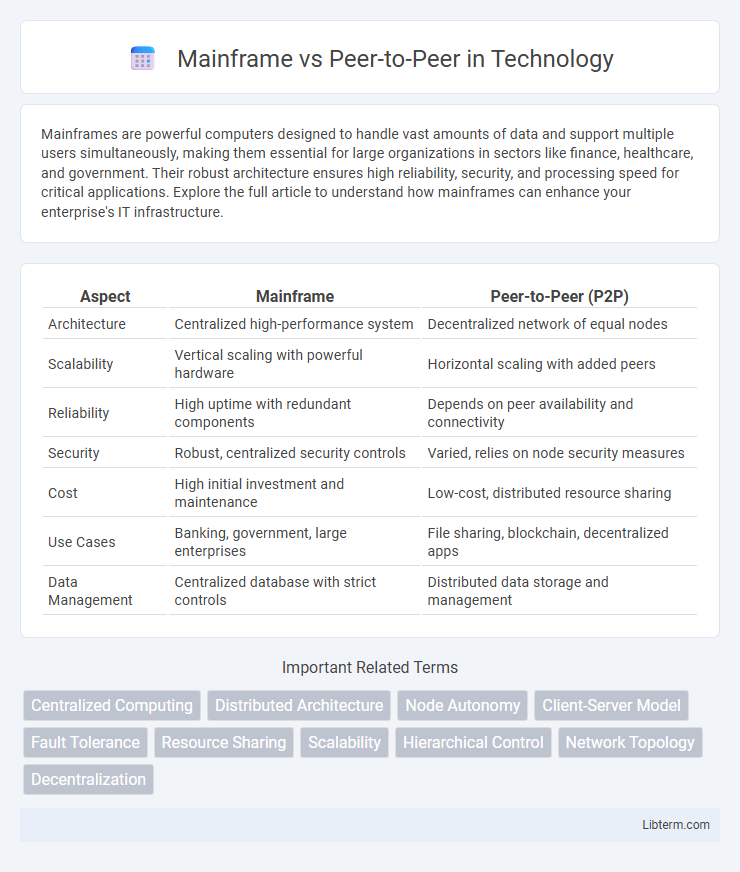Mainframes are powerful computers designed to handle vast amounts of data and support multiple users simultaneously, making them essential for large organizations in sectors like finance, healthcare, and government. Their robust architecture ensures high reliability, security, and processing speed for critical applications. Explore the full article to understand how mainframes can enhance your enterprise's IT infrastructure.
Table of Comparison
| Aspect | Mainframe | Peer-to-Peer (P2P) |
|---|---|---|
| Architecture | Centralized high-performance system | Decentralized network of equal nodes |
| Scalability | Vertical scaling with powerful hardware | Horizontal scaling with added peers |
| Reliability | High uptime with redundant components | Depends on peer availability and connectivity |
| Security | Robust, centralized security controls | Varied, relies on node security measures |
| Cost | High initial investment and maintenance | Low-cost, distributed resource sharing |
| Use Cases | Banking, government, large enterprises | File sharing, blockchain, decentralized apps |
| Data Management | Centralized database with strict controls | Distributed data storage and management |
Introduction to Mainframe and Peer-to-Peer Architectures
Mainframe architecture centers on a powerful centralized computer that handles extensive data processing and supports numerous user terminals simultaneously, ideal for large-scale enterprise applications. Peer-to-peer (P2P) architecture distributes tasks and data among interconnected nodes, enabling decentralized resource sharing and direct communication between users without a central server. Understanding the fundamental distinctions between mainframe's centralized control and P2P's distributed network is crucial for selecting the appropriate infrastructure based on scalability, security, and resource management needs.
Core Principles of Mainframe Computing
Mainframe computing centers on centralized processing, where a powerful mainframe handles large-scale transaction processing, resource management, and data security for multiple users simultaneously. It relies on robust fault tolerance, high availability, and extensive batch processing capabilities, ensuring continuous operation and data integrity in enterprise environments. Unlike peer-to-peer networks that distribute resources across nodes, mainframes prioritize centralized control, scalability, and comprehensive system management.
Fundamentals of Peer-to-Peer Networks
Peer-to-peer (P2P) networks distribute data and resources directly among connected devices, eliminating reliance on a central mainframe or server. Each node in a P2P network acts as both a client and a server, enabling decentralized communication, equal privileges, and shared workloads. This fundamental structure enhances scalability, fault tolerance, and resource utilization compared to traditional mainframe-centric architectures.
Key Differences Between Mainframe and Peer-to-Peer Models
Mainframe models centralize computing power, relying on a single, powerful server to manage large-scale data processing and high-volume transaction handling, while peer-to-peer (P2P) networks distribute workloads across interconnected nodes with equal authority and resource sharing. Mainframes emphasize security, reliability, and centralized control, ideal for enterprise applications like banking systems, whereas P2P provides decentralized resilience and scalability, commonly used in file sharing and blockchain technologies. The fundamental difference lies in architecture: mainframes operate on a centralized model promoting controlled access, while P2P networks foster distributed collaboration without a central governing server.
Scalability: Mainframe vs Peer-to-Peer
Mainframe systems offer centralized scalability by upgrading hardware or adding processors to enhance performance, making them suitable for handling large-scale, mission-critical applications. Peer-to-Peer networks scale horizontally by adding more nodes, distributing workloads across multiple devices, which supports decentralized growth and fault tolerance. While mainframes provide predictable and robust scalability, peer-to-peer systems excel in flexibility and cost-effective expansion through distributed resources.
Security Considerations in Both Architectures
Mainframe architectures centralize data processing within highly secure, controlled environments featuring robust access controls, encryption, and comprehensive auditing capabilities, minimizing the risk of unauthorized access. Peer-to-peer (P2P) networks distribute data across multiple nodes, increasing vulnerability to unauthorized access, data interception, and malware propagation due to decentralized control and reliance on node trustworthiness. Security strategies for mainframes emphasize centralized identity management and strict compliance, while P2P systems require advanced encryption protocols, distributed authentication mechanisms, and continuous threat monitoring to mitigate inherent risks.
Cost Implications and Resource Management
Mainframe systems demand significant upfront capital investment and ongoing maintenance costs but centralize resource management, enhancing security and control for enterprise-scale operations. Peer-to-peer (P2P) networks minimize initial expenditures by utilizing distributed resources, reducing reliance on expensive centralized hardware but complicating resource allocation and management due to decentralized control. Evaluating cost implications, mainframes offer predictable expenses with robust resource oversight, whereas P2P solutions provide scalable, cost-effective infrastructure at the expense of increased management complexity.
Performance and Reliability Comparison
Mainframe systems deliver superior performance through centralized processing power, handling vast data volumes with high efficiency and consistent throughput. Peer-to-Peer networks distribute workloads across multiple nodes, enhancing scalability but potentially facing latency and synchronization challenges under heavy traffic. Reliability in mainframes is ensured by robust fault-tolerant architectures and centralized control, while Peer-to-Peer relies on decentralized redundancy, which can suffer from node failures affecting overall network stability.
Use Cases: When to Choose Mainframe or Peer-to-Peer
Mainframe systems excel in large-scale, mission-critical environments such as banking, insurance, and government agencies, where high transaction throughput, security, and centralized control are paramount. Peer-to-peer networks are ideal for decentralized applications like file sharing, collaborative workspaces, and small-to-medium business networks requiring scalability and direct resource sharing without a central server. Selecting mainframe is optimal for processing vast amounts of data with robust reliability, while peer-to-peer suits scenarios demanding flexibility and reduced infrastructure costs.
Future Trends in Computing Architectures
Future trends in computing architectures indicate a growing convergence between mainframe systems and peer-to-peer networks, leveraging the scalability and robustness of mainframes alongside the decentralization and fault tolerance of peer-to-peer models. Emerging technologies such as quantum computing integration, edge computing, and blockchain enhance the hybrid architectures, enabling improved data processing speeds, security, and decentralized data management. The adoption of AI-driven automation and cloud-native solutions further accelerates the evolution of these architectures toward more adaptive, resilient, and scalable enterprise computing environments.
Mainframe Infographic

 libterm.com
libterm.com